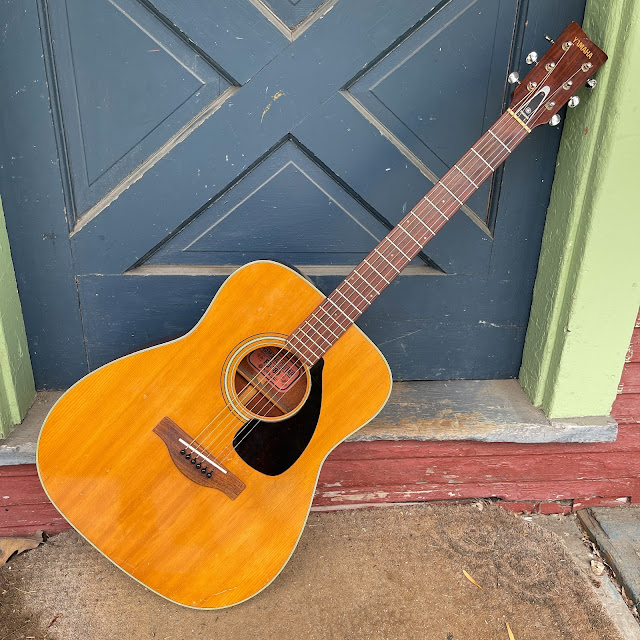1960s Yamaha FG-180 "Red Label" Jumbo Guitar
FG-180s are great guitars. Lately, every time one comes in via a customer I hear "Elliot Smith" grace the lips of the owner because he was known to play one relentlessly. This particular model has become so mythologized on the net and forums that the hype is starting to get a little bit silly. Although I didn't get a video of this one, I do have a few others in the archives -- click here to see and hear another one.
Let's cut to the chase, though: these are plywood guitars made for mass-market appeal. The design on them is phenomenal -- the bracing is light, the body is cut just so to emphasize a full, warm bass and clean midrange, and they're reliable and incredibly sturdy. They have a pleasing sound and plenty of volume. They are not a replacement for a "high-end" big guitar like a D-18, D-28, or J-45 -- all of which will do a number of these things and then also excel as melody-pickers, too -- but they might just be the only flattop you could ever really need if your main role with an acoustic is chord-slinger, folk-singer, or backup player.
So: I like them. I always have. I think the whole Yamaha lineup of plywood flattops from the late '60s through the '80s is good stuff and well-built, though like other ply guitars the high-end response is sort-of zippily plastic and flat (in comparison to a good, solid-top guitar), which is why I don't think of them as great flatpicked lead instruments. Fingerpicked melody sounds good on them, though.
I've (personally) never bonded with the medium-bigger fat C neck profile or wide radius of the fretboard, so while I've owned dozens of these over time and enjoy them for cowboy chords, I never wind-up keeping one for myself because the neck doesn't appeal to me personally. I can't tell you how many times someone comes in and says, "oh, I love the wide neck profile, it's great for my hands!" when they drop one off for service, though.
As far as what these guitars need after a while -- they need the same basic stuff almost all older guitars do -- a neck reset and fret level/dress followed by a new saddle, usually, during setup. Once you bite the bullet these will remain stable, faithful guitars for decades. They started-off as stable, faithful guitars but just like any dovetail-joint acoustic, the angle changes with age and needs knocking-back. Sure, they also get a little belly around the bridge, too. Don't worry about it. It's what guitars do.
This one got a neck reset, fret level/dress, new saddle, and setup work and now it's playing bang-on. I only had time to snap a few pics as the owner picked this up about a half-hour after completion.









Comments